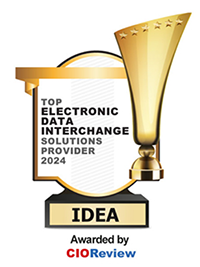Electronic Data Interchange (EDI): More Than Purchase Orders and Invoices
Week #1 of IDEA’s EDI Masterclass: Your Ultimate Guide to Streamlining Business Processes with Electronic Data Interchange
By Tom Guzik, Director, Digital Integration Services, IDEA

If you’re only using Electronic Data Interchange (EDI) for Purchase Order (EDI 850) and the Invoice (EDI 810), you’re missing opportunities to streamline and automate business processes. Tapping into the plethora of available transaction sets can significantly increase cost savings and operational efficiencies.
320+ More EDI Transaction Sets
The American National Standards Institute (ANSI) Accredited Standards Committee (ASC) X.12, the organization responsible for developing and maintaining EDI standards in the United States, offers 323 transaction sets. Each set represents a different type of electronic communication that can replace or enhance a manual business process. Yet, 11% of IDEA Exchange subscribers are using two or fewer EDI transaction sets.
Why not take advantage of these opportunities for automation? Sure, maybe your company only implemented EDI to comply with a mandate from a major trading partner. And, sure, the myriad transaction sets available can make deciding where to start a daunting task, but with ASC X.12’s categorization of these transaction sets, it’s easier to identify which documents align with specific areas of your business.
EDI Transaction Set Categories
Each transaction set category corresponds to a different aspect of business operations, like the following examples:
- Communications & Controls
- EDI 242: Data Status Tracking
- Finance
- EDI 810: Invoice
- EDI 820: Payment Order/Remittance Advice
- Government
- EDI 805: Contract Pricing Proposal
- EDI 813: Electronic Filing of Tax Return Data
- Transportation
- EDI 210: Motor Carrier Freight Details and Invoice
- EDI 214: Transportation Carrier Shipment Status Message
- Supply Chain
- EDI 180: Return Merchandise Authorization & Notification
- EDI 845: Price Authorization Acknowledgment/Status
- Insurance
- EDI 270: Eligibility, Coverage, or Benefit Inquiry
Use these categories to identify which EDI transactions can best solve the efficiency challenges facing your business.
Selecting Transaction Sets to Automate
An effective method for identifying processes ripe for EDI automation is to develop metrics around your company’s operations. For instance, consider tracking the time order entry staff spends manually entering purchase order lines into your order management system. By focusing on the number of lines rather than the number of orders, you’ll comprehend the time and resources consumed by manual data entry.
Once you’ve established these metrics, you can easily identify the most resource-intensive processes and target them for EDI automation. This data-driven approach will help maximize return on EDI investment.
How IDEA Exchange Customers Use Transaction Sets
In the IDEA Exchange network, trading partners exchange close to 60 unique EDI and EDIFACT document types every month. Beyond purchase orders and invoices, our customers are finding innovative ways to utilize EDI in addressing a wide range of business needs, including:
Communications & Controls
Companies use EDI 242 to track status of critical data exchanges while EDI 864 facilitates text messages for quick updates or alerts.
Finance
Companies dealing with large volumes of payments, such as retailers and distributors, use EDI 820 Payment Order/Remittance Advice to automate payment processing, which reduces manual intervention and minimizes errors.
Government
With EDI 813, companies can electronically file tax return data to ensure accuracy. EDI 805 enables faster, more efficient government procurement processes by submitting contract pricing proposals.
Transportation
EDI 214, the Transportation Carrier Shipment Status Message, provides real-time updates on shipment status, helping companies better manage supply chains and reduce the risk of delays or lost shipments. EDI 210 automates invoicing for motor carrier freight, improving accuracy and accelerating payment cycles.
Supply Chain
EDI 180 facilitates the return merchandise authorization process, ensuring that returned goods are processed quickly and accurately. EDI 845 streamlines pricing agreements between trading partners with price authorization acknowledgments.
Insurance
EDI 270 automates customer information verification in eligibility, coverage, and benefit inquiries. EDI 837, a healthcare claim document, handles insurance claim submission and processing, reducing paperwork and expediting reimbursements.
Maximizing Your EDI Investment
Think beyond compliance and consider how EDI can be integrated into your broader business strategy. Whether you’re looking to consolidate supply chain transactions, improve financial processes, or enhance customer service, there’s likely an EDI transaction set that can help you achieve your goals. Explore the full range of available EDI transaction sets to identify new opportunities to automate manual processes, reduce costs, and improve overall efficiency.
If you’re ready to take your EDI program to the next level, consider exploring the full range of EDI documents available on the IDEA Exchange network. If you have any questions or need guidance on which transactions might be right for your business, please contact your IDEA Exchange Account Executive or Ilene Bromberg at 703-562-4689 or ibromberg@idea4industry.com. We look forward to helping you unlock the full potential of EDI for your business.

